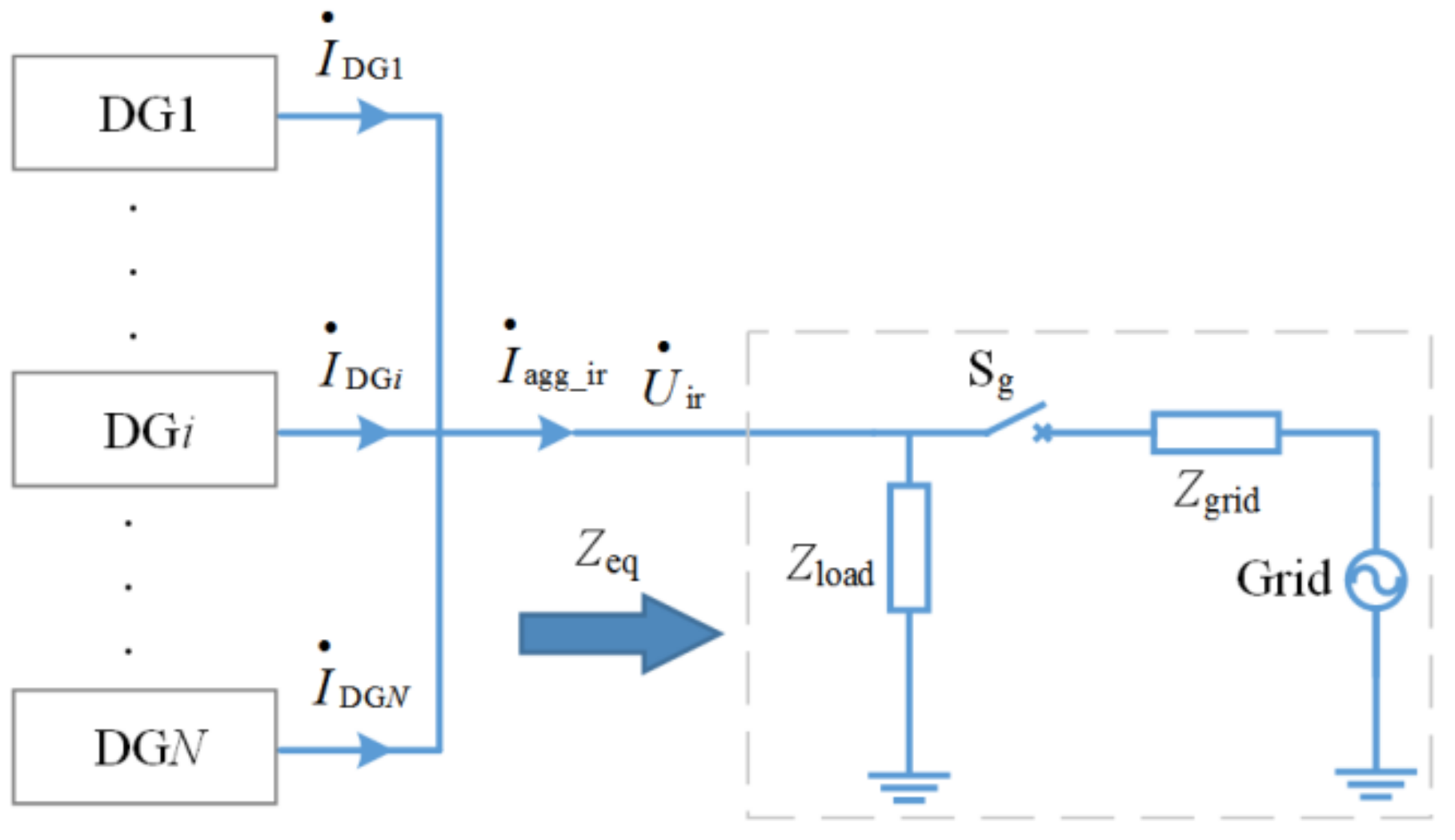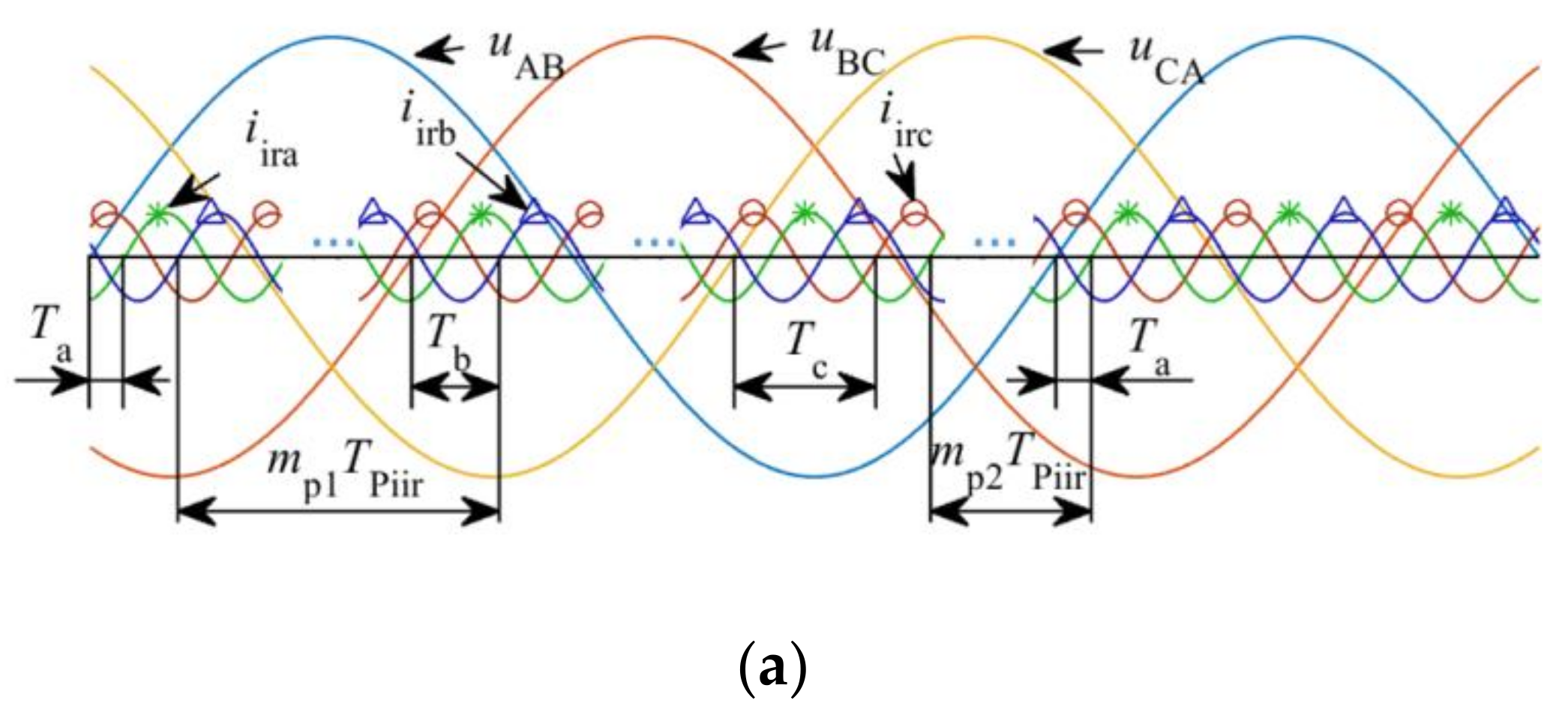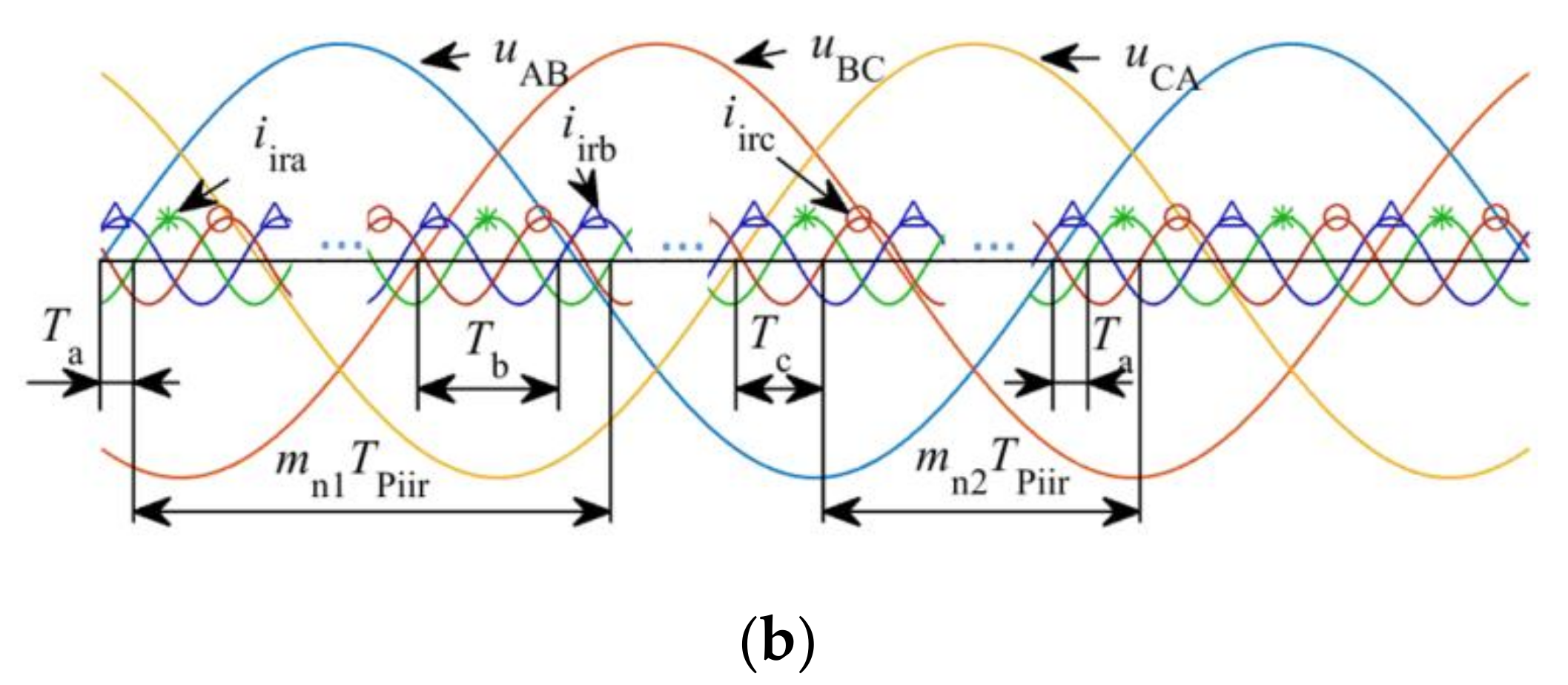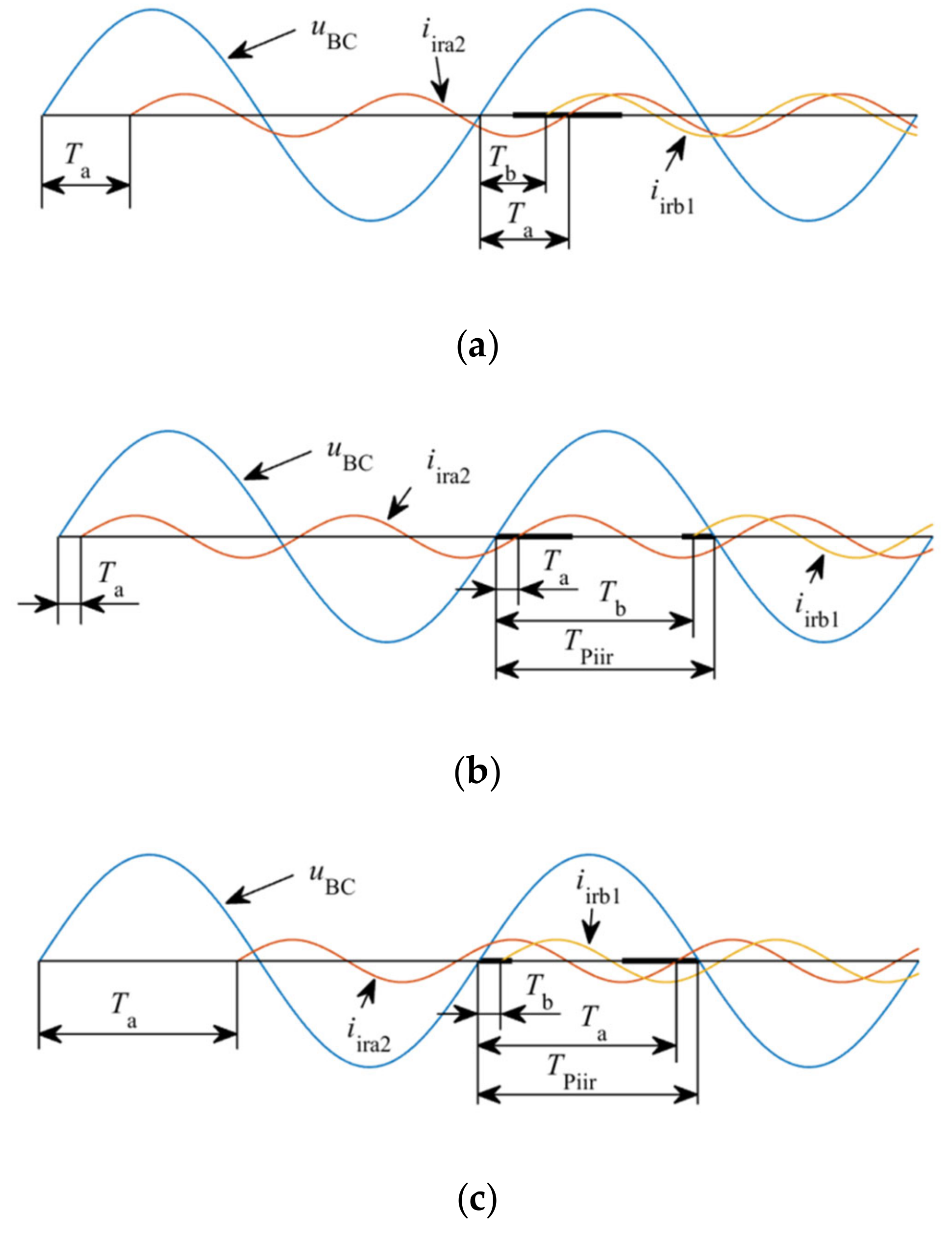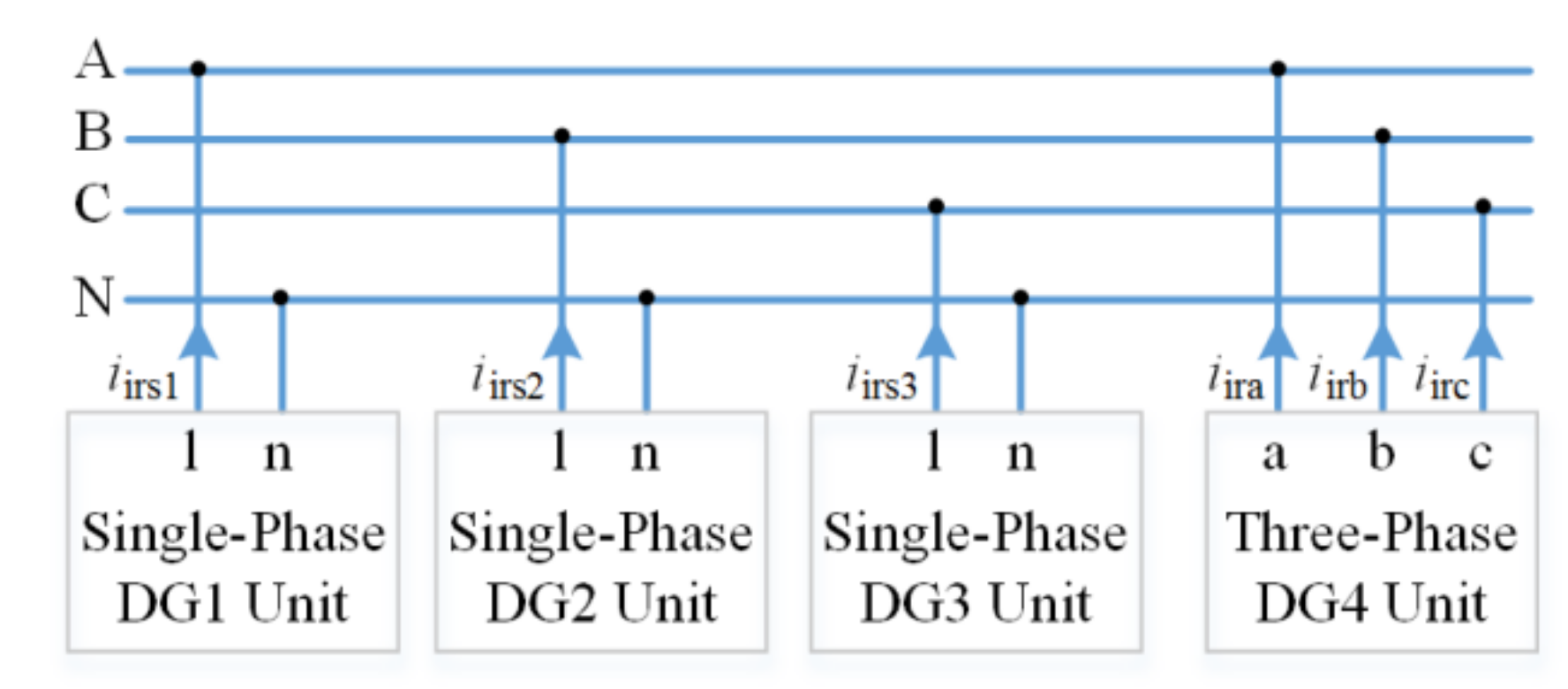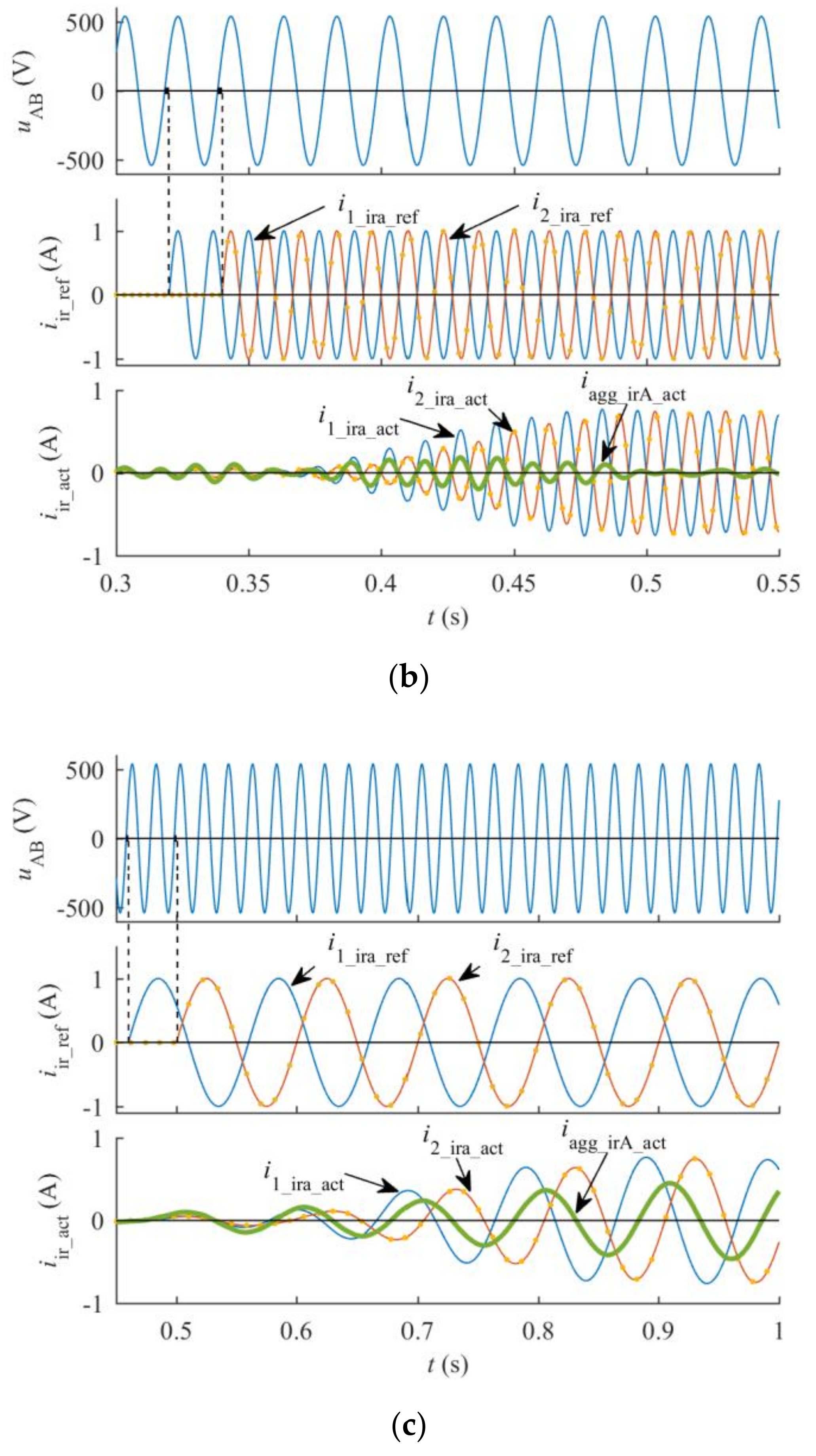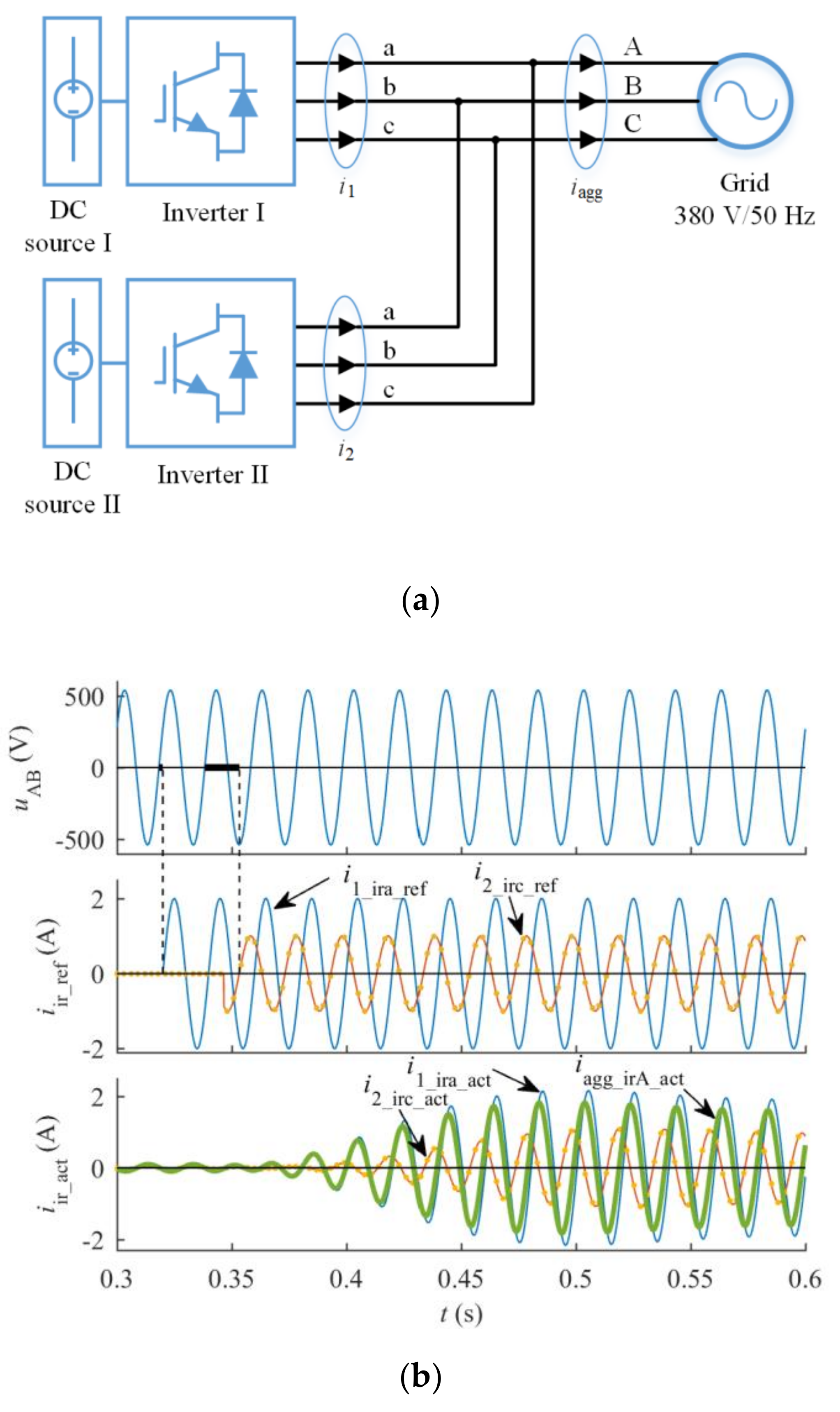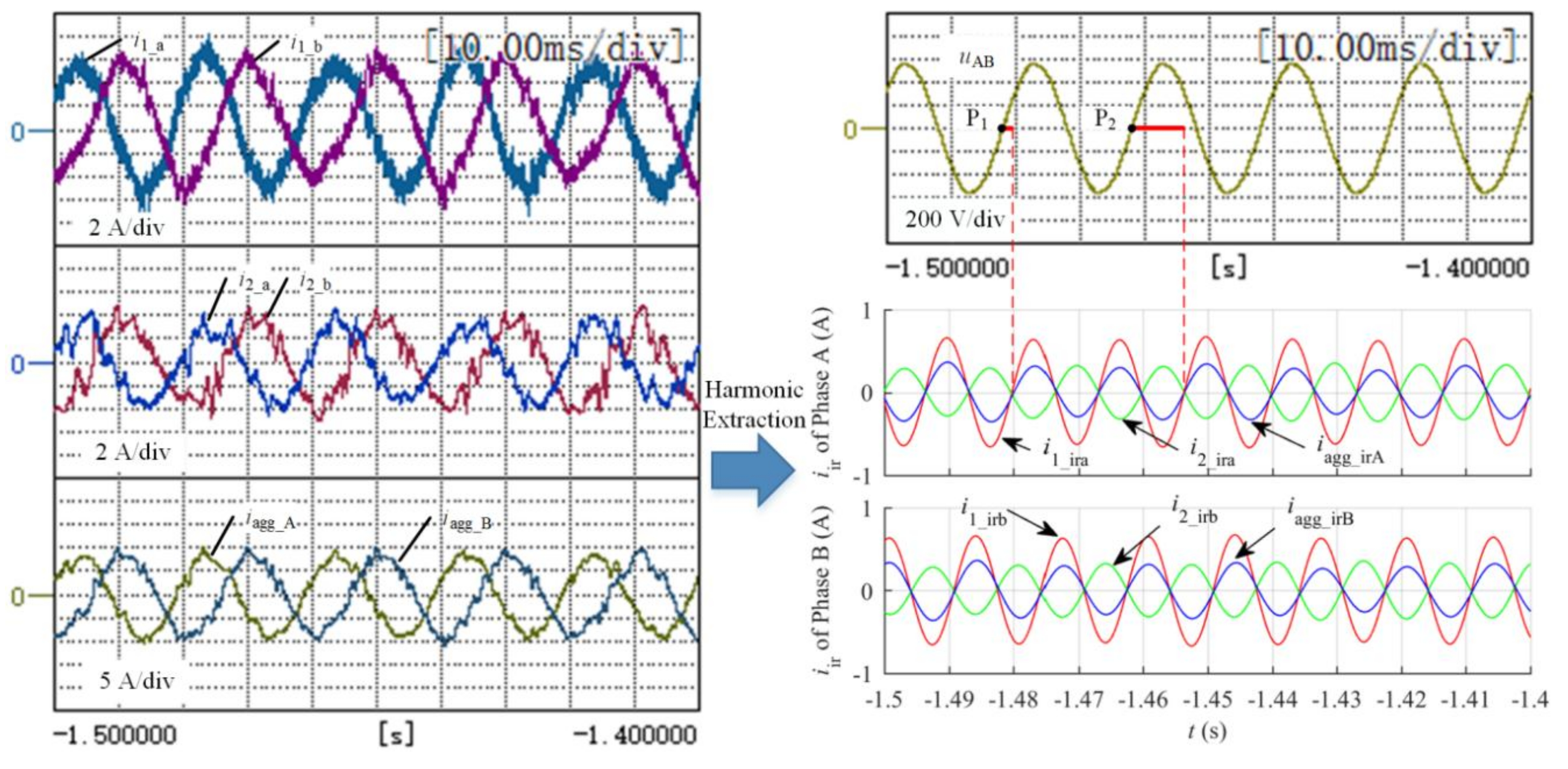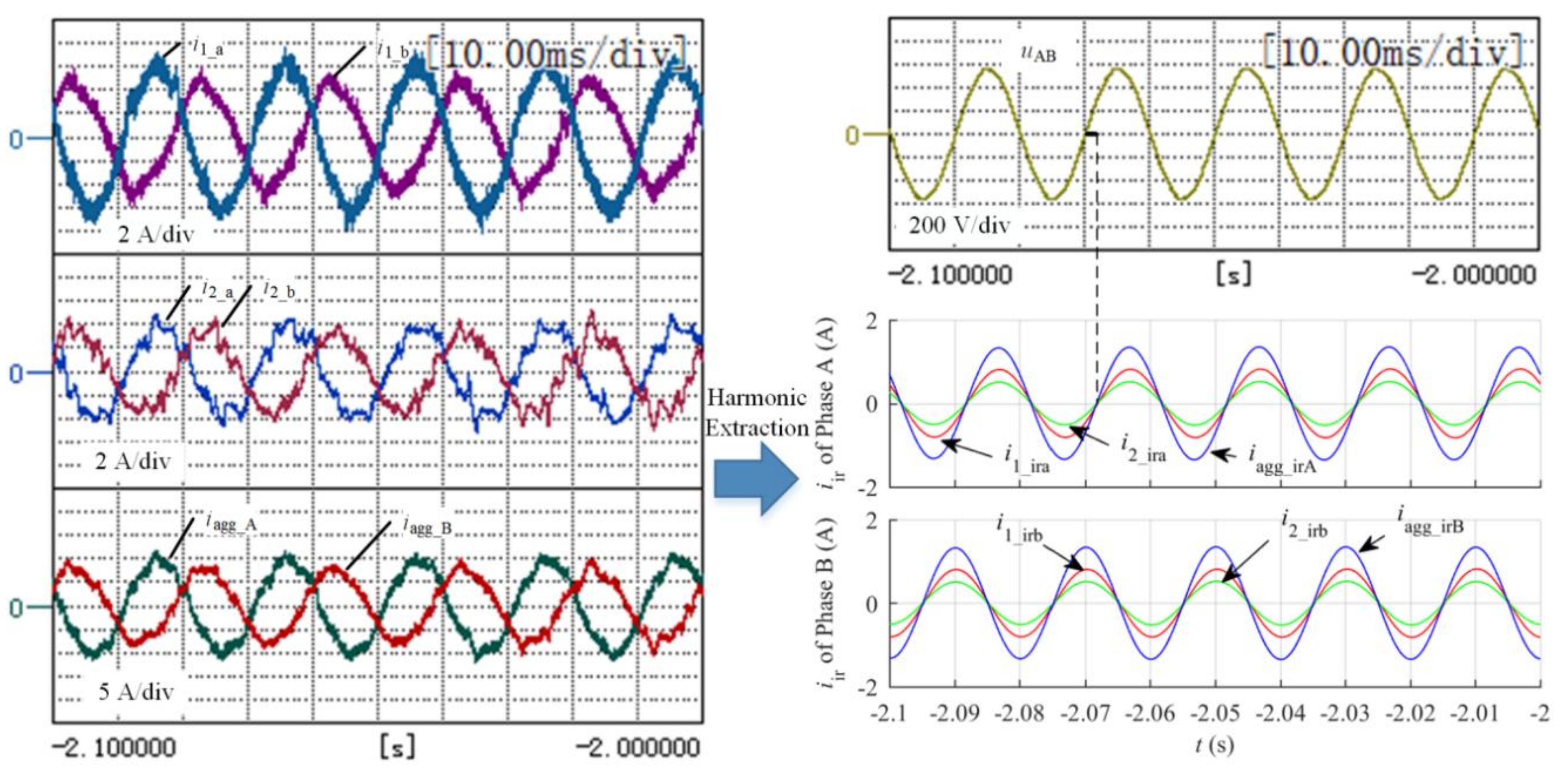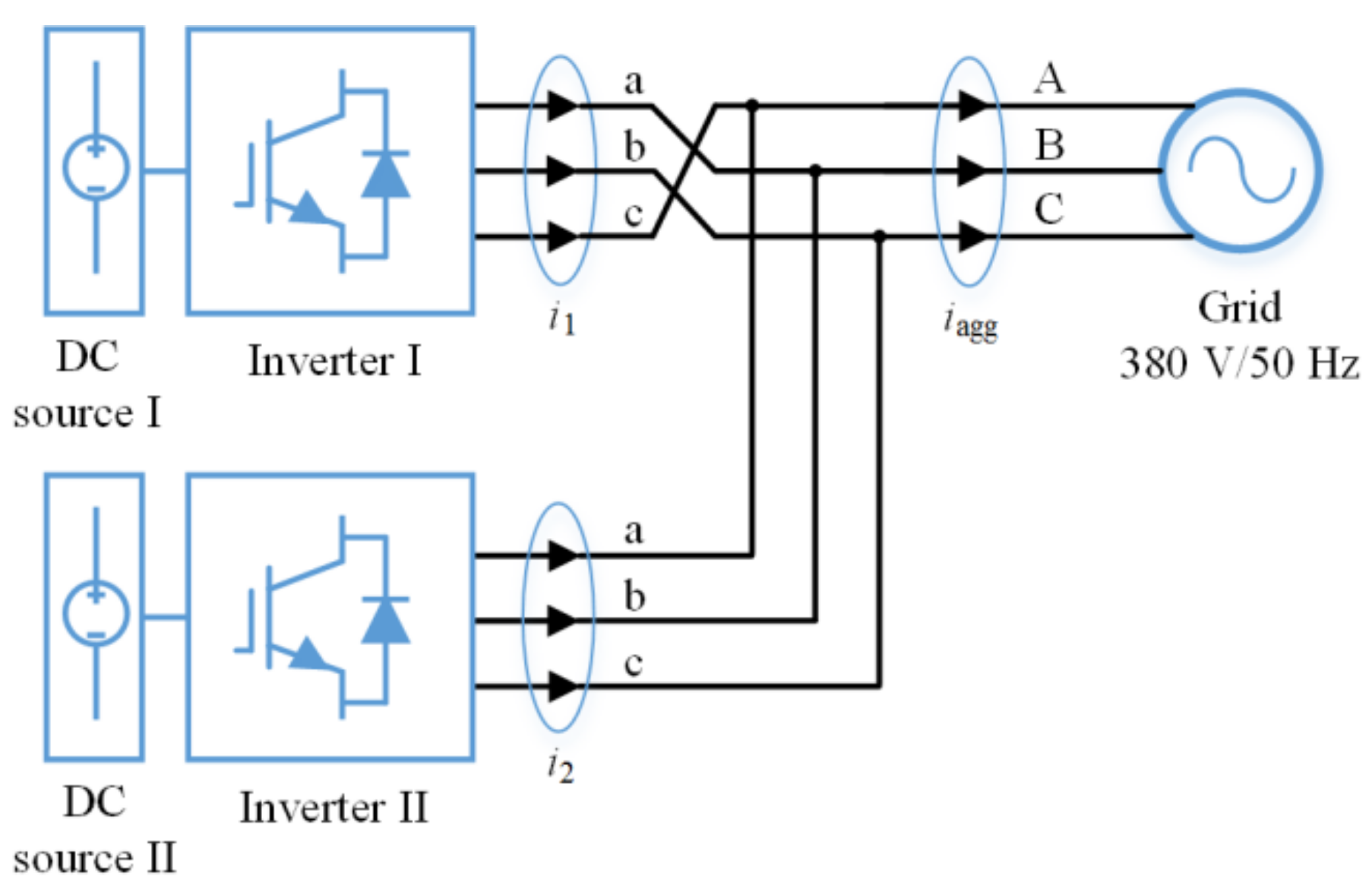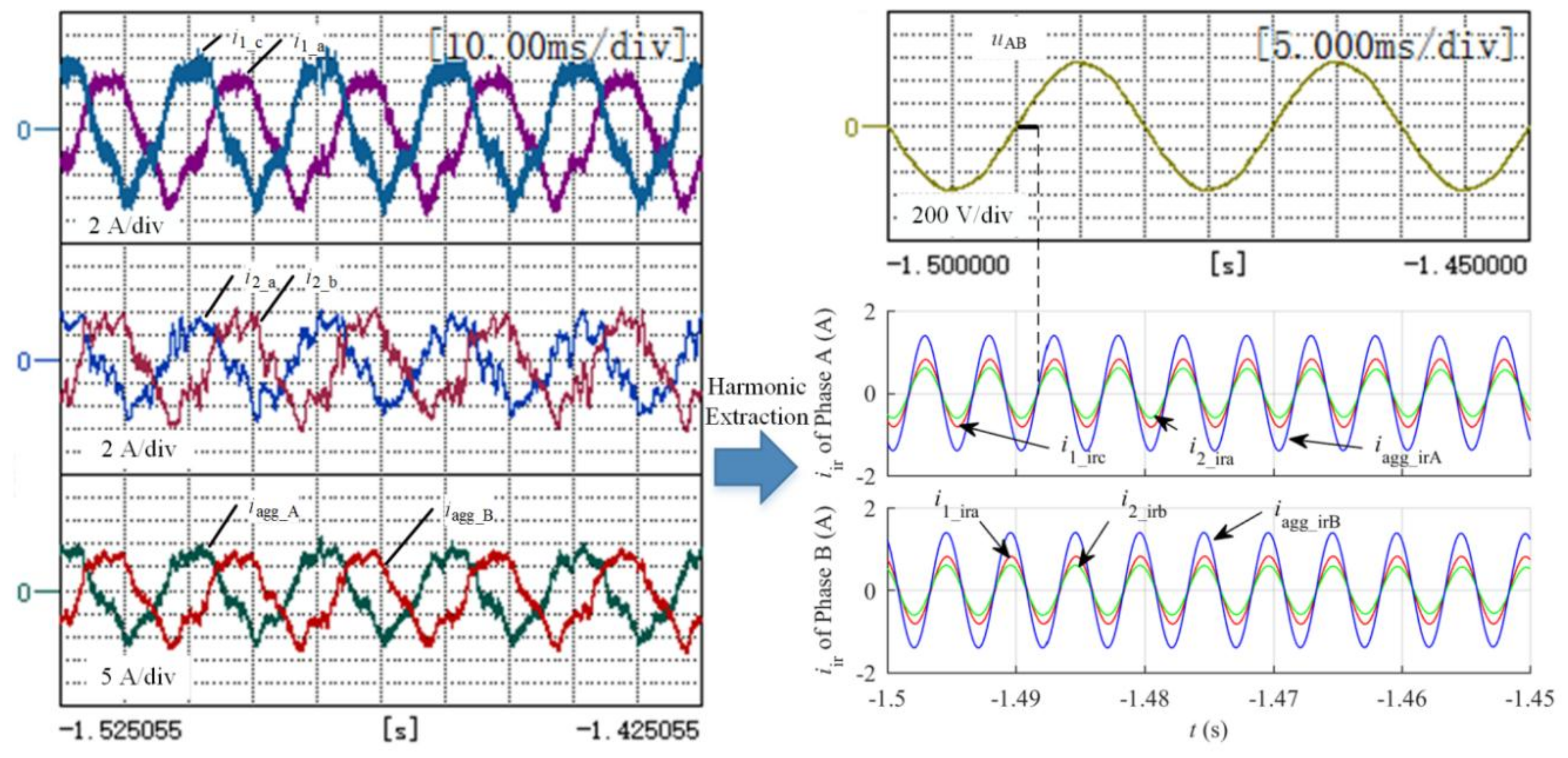1. Introduction
In distributed generation (DG), DG units are dispersed in various areas with associated loads. If a main grid is lost for some reason, the DG units and loads connected with it before will form an electricity island. In this island, if the power is matched, the DG units and loads will continue to run. This situation is out of power dispatching and monitoring and is harmful to personal and equipment safety, for which reason it must be detected rapidly. Islanding detection arises from this. So far, a large number of islanding detection methods have emerged. In general, these methods are divided into remote methods, passive methods and active methods. The active methods are very cost-effective and thereby attract a lot of studies. This paper will discuss a main type of active method named the irregular current injection method.
According to the irregular current injection method, a DG unit (seen as a current source) injects high/low frequency currents or negative sequence fundamental frequency currents into the network and observes the resultant voltages to detect an island [
1,
2,
3,
4,
5,
6,
7,
8,
9,
10,
11,
12,
13,
14,
15,
16,
17,
18]. In practice, there are some special circuit topology and control algorithms, and then how to inject a harmonic under such conditions is an interesting topic [
1,
4]. Regarding the specific implementation of harmonic injection, a scheme based on a d-q reference frame was proposed in [
2], which was similar to a fundamental current control, and another scheme based on static reference frame and PR (Proportional Resonant) regulators was proposed in [
7]. To cope with unbalanced grid impedance scenarios in islanding detection, a scheme was proposed in [
3], which injected dual-frequency harmonic currents. Besides the sinusoidal current injection, a pulse current injection is also an option and has been studied in [
5]. Negative sequence fundamental currents have been widely used in literature, for they have been extensively studied in other fields, and the manner in which such currents can be exploited for islanding detection was introduced in [
6,
9,
12]. In addition, it is also very common to measure network impedance by means of the harmonic voltages and currents, for an island event may result in a surge of the network impedance [
10,
11]. Island misjudgment is a problem that must be faced in islanding detection. In [
18], a scenario that may result in a misjudgment was discussed; the reason for the misjudgment was analyzed and a solution was proposed. On the contrary, in [
13,
14,
15,
16,
17], irregular voltage injection was exploited for islanding detection, by which the DG units were presented as voltage sources, and the problems with multi-DG operation were addressed.
Moreover, many other islanding detection methods are also widely used. A frequency shift method, which is another classic type of active method, was introduced in [
19]. Actually, this frequency shift method was mixed with a passive method, and such a hybrid method was the future development trend. A passive method based on measuring the frequency-dependent impedance at an inverter terminal was employed in [
20]. A remote method exploiting the phasor measurement unit to collect the related information of an island was employed in [
21]. Additionally, the control strategy during islanding operation was also explored in some literature. [
22,
23] contributed two schemes for controlling DG units during grid-connected and islanding operation.
The above section has mentioned that the principle of irregular current injection methods is to inject irregular current first and then observe the response. This paper will focus on the issue at the injection stage. Since generally there is no communication between DG units, the injected irregular currents cannot be coordinated. Thus, in particular, their phases are independent, for which reason the irregular currents at the same frequency may cancel each other out and thereupon their convergent current may be too small to cause a detectable response. This issue is called the compatibility issue in this paper, and it may severely affect islanding detection. This paper will analyze this issue in detail and study how to cope with it.
Furthermore, the above compatibility issue is based on the currents at the same frequency. The currents at different frequency (and their responses) can be extracted from their syntheses, and thus there is no such issue between the methods that inject different frequency currents, while these methods will not affect each other either with respect to islanding detection. In fact, for islanding detection methods, all the active methods thereof have the compatibility issue due to their exciting-observing response mechanism. For frequency shift methods, a design criterion from the requirement of synergy between DG units has been derived in [
24], which can actually be seen as a strategy coping with the compatibility issue.
This paper is organized as follows:
Section 2 explains the compatibility issue of irregular current injection methods;
Section 3 introduces a solution to this issue;
Section 4 discusses some other factors relating to irregular current injection;
Section 5 summarizes the results obtained from the previous theoretical analyses;
Section 6 verifies the solution by both simulations and experiments; and finally, a conclusion is drawn.
3. A Solution to the Compatibility Issue
Considering that there is no communication between DG units, to make the aforementioned phase difference within [−π/2, π/2], a common reference quantity is introduced to conduct irregular current injection. The terminal voltage of DG units, i.e., utility grid voltage, is a natural reference throughout the available quantities. This section will expound how to obtain compatibility on the basis of a terminal voltage reference.
3.1. Injection Pattern
In this paper, for a DG unit, such as an inverter, in order to facilitate the implementation, an irregular current is injected in this pattern: the first zero phase of the irregular current
iir lags a zero phase of the terminal voltage
utm by
Tlag (time), which is less than a period of both
iir and
utm, as shown in
Figure 2.
Tlag is expressed in terms of time rather than angle because the frequencies of the irregular current and terminal voltage may be different. Additionally, it is found that other injection patterns based on a terminal voltage reference can actually be attributed to this pattern.
The following takes the DG1 and DG2 units in
Figure 1 as an example to analyze how to achieve the mentioned phase difference requirement. If
iDG1 and
iDG2 are injected one after the other, the resultant waveforms are shown in
Figure 3.
The relationship in (2) can be obtained from
Figure 3:
where
TPu and
TPiir are the periods of the terminal voltages and irregular currents, respectively;
m is a positive integer;
n is a non-negative integer; and there are:
Mathematically, in Equation (2),
n and
kTPiir can be seen as the quotient and remainder of
mTPu divided by
TPiir, respectively. The relationship between
m and
n can be obtained from
Figure 3 and the relationship between
TPu and
TPiir. For example, for high frequency currents, there is
TPu >
TPiir. If
n <
m, there will be
n +
k <
m, and then Equation (2) cannot be established. Thus, there must be
n ≥
m.
Equation (2) can be also rewritten as in (3), where fu and fiir are the frequencies of the terminal voltages and irregular currents, respectively, i.e., 1/TPu and 1/TPiir.
To obtain compatibility, from
Figure 3,
k should be in the [−1/4, 1/4] interval, since it corresponds to Δ
φ12 (i.e., the phase difference mentioned in
Section 2.2) in the [−π/2, π/2] interval.
fu is certain and
m represents the number of voltage cycles, which means
m may be any positive integer. Thus, for a given
fiir, if any value of
m (i.e., any positive integer) can make
k within [−1/4, 1/4] according to (3), this
fiir is usable, otherwise it is unsuited to be used as an irregular current frequency. In other words, a usable
fiir must be verified by all values of
m, whereas an unusable
fiir only needs to be verified by one value of
m.
3.2. High-Frequency Current
Equation (4) can be obtained by substituting
m = 1 into (3):
where
n1 and
k1 represent
n and
k when
m = 1, respectively, as is the case hereafter;
n1 is a positive integer due to
fiir >
fu; and −1/2 ≤
k1 ≤ 1/2 in accordance with (2).
According to the conclusion in
Section 3.1,
k1 should be in [−1/4, 1/4]. Thus,
fiir which makes
k1 outside this interval is unusable and is not considered below.
Then, by substituting
m = 2 into (3), there is (5):
where
n2 is an integer greater than 1 and −1/2 ≤
k2 ≤ 1/2.
The equation below can be derived from (4) and (5):
So far,
k1 has been constrained to be in [−1/4, 1/4], and thus, according to the above equation, Equation (6) is true considering that
n1 and
n2 are non-negative integers:
For m = 2, k2 should be also within [−1/4, 1/4]. Thereupon, the usable interval of k1 is compressed into [−1/8, 1/8] due to the above relationship, and the fiir corresponding to those k1 that have been filtered out will no longer be considered.
As above, when m = 3, the usable interval of k1 is further compressed into [−1/12, 1/12]. Hence, the usable intervals of k1 with the increase of m can be shown below.
When
m→+∞,
k1 can only be taken to zero, which means that
k2 can only be zero due to (6), and the same is true for
k3,
k4, …. Consequently, considering—(4) and (5), there are the following equations:
Since a usable
fiir must be verified by all values of
m, a usable
fiir must satisfy all of the above equations. Through the intersection operation on the above equations, the final expression of the usable
fiir can be derived, as shown in (7):
where
p is an integer greater than 1.
The above expression shows that only the frequencies that are integer multiples of the terminal voltage frequency are usable for high frequency currents.
3.3. Low-Frequency Current
In the same way, when m = 1, (4) is still true, and for low frequency currents, there are n1 = 1 or 0, and −1/2 ≤ k1 ≤ 1/2 and k1 ≠ 0.
By following the derivation in
Section 3.2, it can be found that there is not a suitable value for
k1 considering
k1 ≠ 0. In other words, low frequency currents are unsuited to be used as injected currents.
3.4. Negative Sequence Fundamental Frequency Currents
This type of current only exists in three-phase systems. Up to now, such currents have seemed to be usable, since (2) indicated that k = 0, i.e., within [−1/4, 1/4].
3.5. Practical Applications in Three-Phase Systems
In inverter-based three-phase DG systems, due to a lack of a relevant knowledge, carelessness or some other reasons, there may be a fault whereby the phase symbols of an inverter do not correspond to that of the system, while their phase sequence is the same. This fault is called a phase symbol fault in this paper, and it cannot be detected by a DG unit itself or even be seen as a fault. This scenario, as DG2 and DG3 units shown in
Figure 4, is acceptable in terms of generation. Accordingly, irregular current injection islanding detection methods must also be able to tolerate this fault. As for the fault that a DG unit mismatches the phase sequence, as the DG4 unit shown in
Figure 4, it will be detected by the DG unit. Depending on the technical route, the DG unit may adjust its inner phase sequence to adapt this fault, by which this fault is translated into a phase symbol fault, or the DG unit may refuse to start and issue a warning. Accordingly, this fault is seen as a phase symbol fault below.
(1) Positive Sequence High-Frequency Currents: We take the DG1 unit in
Figure 4 as an example, where the reference terminal voltages of the irregular currents
iira1,
iirb1 and
iirc1 are the line voltages (i.e., phase-to-phase voltage)
uAB,
uBC and
uCA respectively, and
Tlag is appointed as
Ta,
Tb and
Tc, respectively.
The time interval between the zero phase of a reference terminal voltage and the zero phase of an irregular current immediately following it is defined as the zero phase interval hereafter. The first zero phase interval must be
Tlag for an irregular current in accordance with the aforementioned injection pattern, and once (7) is met, each subsequent zero phase interval will be
Tlag. Thus, the positive sequence irregular current injection is shown in
Figure 5a.
In
Figure 5, the phase difference of 2π/3 between any two irregular currents corresponds to a time of
TPiir/3, while the phase difference of 2π/3 between any two voltages corresponds to a time of
TPu/3. Accordingly, Equations (8) can be obtained from
Figure 5a:
where
mp1 and
mp2 are non-negative integers, and each non-negative integer may be the value of
mp1 and
mp2. For a certain irregular current (i.e., with a certain
TPiir),
Tb and
Tc are determined by
Ta. Consequently, only
Ta needs to be set for three-phase DG units.
In
Figure 4, the actual reference terminal voltage of both
iirb1 and
iira2 is
uBC, while their
Tlag are
Tb and
Ta, respectively. To make the phase difference between
iirb1 and
iira2 within [−π/2, π/2] for they converge in phase B, the time difference between the zero phases of
iirb1 and
iira2 should be in [−
TPiir/4,
TPiir/4]. Therefore, the inequality below should be satisfied, where
Tint can be one value of 0, −
TPiir and
TPiir, and the three values correspond to the three scenarios shown in
Figure 6:
Then, Equation (9) can be derived from the above inequality and (8), where
q is a positive integer. For the other irregular currents in
Figure 4, this equation can also be derived:
(2) Negative Sequence Fundamental/High-Frequency Currents: The injection of such currents is shown in
Figure 5b. As in (8), there are similar equations, as shown in (10):
where
mn1 and
mn2 are non-negative integers, and each non-negative integer may be the value of
mn1 and
mn2.
By following the derivation for positive sequence high frequency currents above, Equation (11) can be obtained:
Equations (9) and (11) show further constraints on the frequencies of positive sequence current and negative sequence current, respectively. In addition, since the right side of (11) cannot be 1, the negative sequence fundamental frequency currents are unusable.
3.6. Practical Applications in Single-Phase Systems
For ease of use, the parameters of a single-phase DG unit, including the
Tlag, do not need to be modified when the phase that it is connected to is changed. Thus, the single-phase DG units in
Figure 7 must adopt the same
Tlag, which is denoted as
Tl in this paper. Since a single-phase DG unit can distinguish a live wire from a neutral wire, there is not a phase symbol fault as above.
Meanwhile, single-phase DG units should be compatible with three-phase DG units. Thus, in
Figure 7, the phase difference between irregular currents
iirs1 and
iira must be in [−π/2, π/2] (i.e., the time difference between the zero phases of
iirs1 and
iira should be in [−
TPiir/4,
TPiir/4]), as for the other irregular currents. Since the reference terminal voltage of a single-phase DG unit is a phase voltage, e.g.,
uAN for
iirs1, considering that
uAN lags
uAB by π/6 (time of
TPu/12), as shown in
Figure 8,
Tl should be set as (12), where
ma (as well as
mb and
mc, to be mentioned later) is an integer.
Moreover, for phases B and C, the relationships below should be met:
As (12) is mandatory with the setting of
Tl, the main thing is how to ensure that the above two inequalities are true. If
iira,
iirb and
iirc in
Figure 7 are positive sequence currents, by substituting (8) into the above two inequalities and considering (12), a relationship like (9) can be derived with regard to
fiir. In addition, if
iira,
iirb and
iirc are negative sequence currents, by substituting (10) into the above two inequalities and considering (12), a relationship like (11) can be derived. In other words, the frequencies determined by (9) and (11) (disregarding the phase sequence) are usable for single-phase DG units.
After the above analysis, it is found that the usable irregular currents are those with the frequencies determined by (7), i.e., integer multiple harmonics. The orders of 3q + 1 are assigned to positive sequence currents and single-phase currents, while the orders of 3q − 1 are assigned to negative sequence currents and single-phase currents, and the remainder are the orders of 3q. It seems that the orders of 3q can be used by single-phase currents, since they are used by neither positive sequence nor negative sequence currents and there is no compatibility issue between irregular currents at different frequencies. The following will study whether it is feasible.
As shown in
Figure 7, it is assumed that the magnitudes of
iirs1,
iirs2 and
iirs3 are the same. Their injections are shown in
Figure 9, where
iirs1 leads
iirs2 by
T12 (Time);
iirs2 leads
iirs3 by
T23; and
ms is a non-negative integer.
From
Figure 9, there is the following relationship:
It can be rewritten as the following equation, where 0 ≤
T12/
TPiir < 1:
By substituting the preceding mentioned three sets of frequencies into the above equation, the results of
T12/
TPiir can be obtained below:
For
T23/
TPiir, the same results as above can be obtained by following the preceding derivation. These results reflect that if the frequency of
iirs1,
iirs2 and
iirs3 is (3
q + 1)
fu,
iirs1 leads
iirs2 by 2π/3 while
iirs2 leads
iirs3 by 2π/3, which means that
iirs1,
iirs2 and
iirs3 are present as a set of positive sequence currents in the system; if their frequency is (3
q − 1)
fu, they will present as a set of negative sequence currents, and if their frequency is 3
qfu, they will present as a set of zero sequence currents. However, zero sequence currents may bring some problems to the system. For example, they may affect zero-sequence relay protection [
27]. When the single-phase DG units are evenly distributed on the three-phase lines,
iirs1,
iirs2 and
iirs3 are likely to possess the same or similar magnitudes. Accordingly, for the frequencies of single-phase currents, the orders of 3
q are not recommended.
3.7. Implementation of the Proposed Solution
For inverter-based DG units, since both fundamental currents and irregular currents are sinusoid, to simplify the control, PR regulation based on α-β reference frame is suggested. The control block diagrams are shown in
Figure 10.
In
Figure 10a, P and N denote the connection position of the multi-route switches when injecting positive sequence and negative sequence irregular currents, respectively, and
A denotes the amplitude of the irregular current. To avoid the accumulation of phase errors resulting from the measurement errors of voltage frequency (i.e.,
ω), the irregular current phase
θir should be reset periodically (shown as Syn. reset in
Figure 10). For an irregular current whose frequency is an integer multiple of the voltage frequency, the irregular current phase should be reset once every voltage cycle. In addition, for the other irregular currents, for example, a current at 75 Hz, since two voltage (50 Hz) cycles include an integer number (three) cycles of this irregular current, the irregular current phase should be reset once every two voltage cycles. The counter in
Figure 10 is used for counting voltage cycles.
4. Other Factors Relating to Irregular Current Injection
(1) Mixed with Existing Irregular Current Injection Methods: Since the irregular currents based on existing methods are not injected according to the proposed solution, they may offset the irregular currents injected according to the solution. Thus, the islanding detection effect will not be improved if there are few DG units employing the proposed solution. In terms of this problem, manufacturers are strongly encouraged to adopt the proposed solution.
(2)
Tlag: A unified
Tlag is critical for the compatibility. This paper has indicated that
Ta and
Tl should meet (12). However, no performance index has been found related to
Tlag, and thus there is not a best value for
Tlag. Accordingly, at present, a feasible way is to specify a value for it by the grid code makers. For example,
Ta and
Tl can be set as in Equation (13).
(3) Resonant Frequency of the Filter of an Inverter: For the most common voltage source inverters, essentially, the irregular current is excited by an output voltage component with the same frequency. Therefore, for an inverter adopting a LC or LCL filter, its irregular current frequency should avoid the resonant frequency of the filter so as not to cause a current spike [
28].
(4) Variation of the Grid Impedance: Some literature has pointed out that grid impedance is frequency-variant, and may be larger than the load impedance at a large enough frequency [
4,
20]. From this point of view, the irregular current frequency should be as small as possible, since a small grid impedance is a necessary condition for irregular current injection methods.
(5) Large Line Impedance: There may be a large line impedance between DG units that are far from each other, by which the terminal voltages of these DG units may be out of phase and thereby the irregular currents cannot be controlled as accurately as expected. At present, there is no good solution to this problem without communication.
5. Discussion on the Proposed Solution
A solution to the compatibility issue can be summarized as the following three points:
- (1)
The terminal voltage of a DG unit is referenced, and the injection pattern of irregular currents is shown in
Figure 2;
- (2)
The usable frequency orders for irregular currents are shown in
Table 1;
- (3)
The used frequency should be as low as possible.
Furthermore, as a specific implementation of the proposed solution, the block diagram in
Figure 10 can be employed by inverters.
In the meantime, it can be seen that along with the growing penetration of low and medium power DG units, particularly those of the plug and play variety, manufacturers, grid code makers and grid operators should cooperate to get both a satisfactory islanding detection effect.
This solution largely solves the compatibility issue, although not completely. In other words, if the phases of the irregular currents are still not managed as they are now, the effect of irregular current injection methods will be uncontrollable in multi-DG operation.
